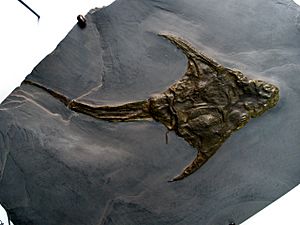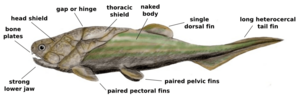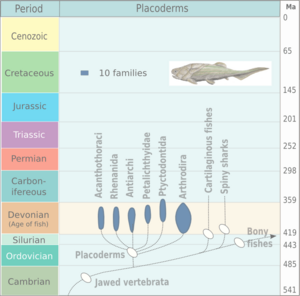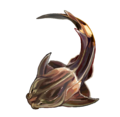Placodermi facts for kids
Quick facts for kids Placoderms |
|
|---|---|
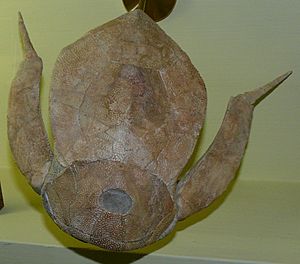 |
|
| Fossil of Bothriolepis panderi showing its caliper-like pectoral fins | |
| Scientific classification | |
| Kingdom: | |
| Phylum: | |
| Subphylum: | |
| Infraphylum: | |
| Class: |
†Placodermi
McCoy, 1848
|
Placoderms (say "Plak-oh-derms") were a group of ancient, armored fish. Their name means "plated skin" in Greek, which makes sense because their heads and chests were covered in strong, bony plates. The rest of their bodies might have had scales or been smooth, depending on the type of placoderm.
These amazing fish lived a long, long time ago, from the middle of the Silurian period to the end of the Devonian period. They were some of the very first fish to have jaws, which was a big step in evolution! One placoderm fossil, found in Australia and 380 million years old, even shows the oldest known example of a creature giving birth to live young.
Placoderms were very successful during the Devonian period, which is sometimes called the 'Age of Fish' because there were so many different kinds. But near the end of the Devonian, many animals in the ocean died out. Since placoderms were mostly predators, they lost their food sources. This caused their numbers to drop quickly, and they all died out by the end of the Devonian period.
Most placoderm fossils have been found in areas that were once part of a huge continent called the Old Red Sandstone. This continent included what is now North America and western Europe. Scientists have been finding placoderm fossils in places like Scotland since the 1700s! More recently, amazing fossils have been found in Australia, in a place called the Gogo formation. This area used to be a reef system, and scientists have found 25 different kinds of well-preserved placoderms there.
Contents
What Were Placoderms Like?
Most placoderms were predators. Many of them lived near the bottom of the water, hunting other creatures. Some, like the Arthrodira, were active hunters that swam in the middle or upper parts of the water.
Placoderms had teeth that were made of bone and a material called dentine. These teeth were similar to the teeth of modern jawed fish. One of the biggest placoderms was Dunkleosteus terrelli, which could grow up to 6 meters (about 20 feet) long! Its fossils have been found in Europe, North America, and possibly Morocco, showing it lived in many places.
Why Did Placoderms Disappear?
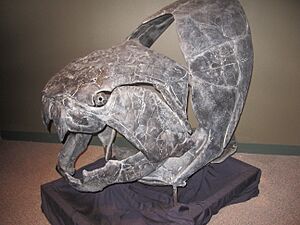
For a while, people thought that placoderms died out because they couldn't compete with the first bony fish and early sharks. Some thought placoderms were too slow. However, scientists now believe that placoderms died out because of big environmental changes and extinction events that happened at the end of the Devonian period. These events harmed marine and freshwater environments, causing many animals, including the placoderms, to disappear.
Types of Placoderms
Scientists divide placoderms into eight main groups, called orders. There are also two other groups, Stensioellida and Pseudopetalichthyida, that scientists are still trying to figure out where they fit. These groups are thought to be very early or "primitive" placoderms.
| Placoderm Orders | ||
|---|---|---|
| Arthrodira | 
|
Arthrodira were the most common and successful placoderms. They were found in many different roles, from huge apex predators to small creatures that ate bits of dead material from the bottom. They had a special joint between their head armor and body armor. This allowed their head shield to move up when they opened their lower jaw, making their mouth opening larger. Most arthrodires didn't have true teeth. Instead, they had sharp bony plates that they used for biting. Their eyes were protected by a bony ring, similar to birds. Early arthrodires, like Arctolepis, were heavily armored and flat-bodied. The biggest arthrodire, Dunkleosteus, was a true "superpredator" that could be 3 to 9 meters (10 to 30 feet) long! In contrast, Rolfosteus was only about 15 cm (6 inches) long. Fossils of Incisoscutum have been found with unborn babies inside, showing that these fish gave birth to live young. |
| Antiarchi | 
|
Antiarchi were the second most successful group of placoderms. The front part of their bodies was very heavily armored, almost like a box with eyes. Their back parts were often flexible and sometimes had scales. Their pectoral fins (the ones on their sides, like arms) were changed into special, caliper-like limbs. In early forms, these limbs were short and thick. In more advanced forms, like Bothriolepis, the limbs were long and had elbow-like joints. Scientists think these limbs helped them pull themselves along the bottom or even bury themselves in the mud. |
| Brindabellaspida |
|
Brindabellaspida were long-snouted placoderms from the Early Devonian period. When first found, they were thought to be similar to another group called acanthothoracids. However, studies of their brains suggest that Brindabellaspis stensioi might be one of the most basic or earliest placoderms, very close to the first placoderm ancestor. |
| Phyllolepida |
|
Phyllolepida were flat placoderms found all over the world. Like other flat placoderms, they were bottom-dwelling predators that would wait to ambush their prey. But unlike most other flat placoderms, they lived in freshwater. Their armor was made of solid plates. Their eyes were on the sides of their heads, which is unusual for bottom-dwelling predators that usually have eyes on top. Their eye sockets were very small, suggesting their eyes might have been tiny or even useless, meaning phyllolepids might have been blind. |
| Ptyctodontida | 
|
Ptyctodontida were lightly armored placoderms with large heads, big eyes, and long bodies. They looked a bit like modern-day chimaeras (also called ratfish). Their armor was reduced to small plates around their head and neck. Scientists believe most ptyctodontids lived near the sea bottom and ate shellfish. Some scientists once thought ptyctodontids might not be placoderms, but instead related to chimaeras. However, detailed studies of their fossils show that while they look similar, they have many important differences. For example, ptyctodontids had bony armor plates, while chimaeras have skin with tiny tooth-like scales. Also, ptyctodontids had beak-like tooth plates instead of true teeth. Male ptyctodontids had special claspers (like fins) near their pelvic area, and possibly on their heads, used for reproduction. |
| Rhenanida |
|
Rhenanida were flat, ray-like placoderms that lived on the ocean bottom. They had large mouths that pointed upwards. Their armor was made of many small, unfused pieces, like a mosaic. Because of this, scientists first thought they were the most primitive placoderms. However, by comparing their skull structures, scientists now believe rhenanids are closely related to the antiarchs. When rhenanids died, their mosaic armor often fell apart, which might be why their fossils are rare. |
| Acanthothoraci |
|
Acanthothoraci were another group of placoderms that looked a bit like chimaeras or small, scaly arthrodires. They had two large spines sticking out from their chests. They also had large scales and plates, beak-like tooth plates, and the typical bony placoderm eyeball. Scientists can tell them apart from other placoderms by the unique patterns on their skull and chest plates. From their mouthplates, it seems acanthothoracids hunted shellfish, similar to modern chimaeras. They might have died out before the mid-Devonian extinction event because they competed with their relatives, the ptyctodont placoderms. |
| Petalichthyida |
|
Petalichthyida were small, flat placoderms with wide fins and many small bumps covering their armor plates. They were most diverse during the Early Devonian period and were found worldwide. Lunaspis and Wijdeaspis are two well-known examples. There was also a unique group of petalichthids in what is now Southern China. After their peak, petalichthids began to decline. Because of their flat bodies, scientists think they were bottom-dwellers that chased or ambushed smaller fish. We don't know exactly what they ate, as no fossils have preserved their mouth parts clearly. |
| Pseudo- petalichthyida |
|
Pseudopetalichthyida are a group of long, possibly flat fish. We only know about them from rare, poorly preserved fossils found in Germany. Like Stensioella heintzi and the Rhenanida, their armor was made of many small, mosaic-like pieces. Scientists are not sure exactly where they fit within the placoderm family tree because there are no complete, undamaged fossils. However, studies suggest they might be a more advanced group of placoderms. |
| Stensioellida |
|
Stensioellida is another mysterious placoderm group, known only from fossils in Germany. Stensioella was a thin fish that looked a bit like a long ratfish. Its armor was a complex mosaic of small, scale-like bumps. While some features of its armor are similar to other placoderms, some scientists debate if it truly belongs in the placoderm group. One paleontologist, Philippe Janvier, has suggested that Stensioella might actually be a type of holocephalian (the group that includes chimaeras). However, others argue that besides a general body shape, the two groups don't have much else in common. |
Images for kids
See also
 In Spanish: Peces acorazados para niños
In Spanish: Peces acorazados para niños


